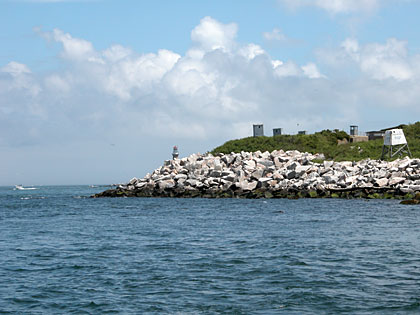 Great Gull Island
Great Gull IslandBy Joan Becker
Photographs by Richard L. Becker
 Great Gull Island
Great Gull IslandSaturday, July 31, 2004
Twenty-seven of us from the New Haven Bird Club crossed Long Island Sound in a fishing boat from Niantic, CT, landing at Great Gull Island 55 minutes later. Great Gull and Little Gull Islands are located at the tip of the northern fork of Long Island. From there, an underwater shelf continues to Fisher Island and the mainland. Although the water depth is about 250-300 feet on either side, huge volumes of water are forced over this shallower 50-100 foot ridge, causing turbulence and navigational hazards in what’s known as The Race. The swift-moving currents and adjacent eddies are magnets for striped bass, bluefish and other sportsfish. Smaller fish are spooked to the surface, creating an ample food supply for the terns. Called “sea swallows” by the fisherman, groups of terns plunge-diving for baitfish indicate the presence of sportsfish.
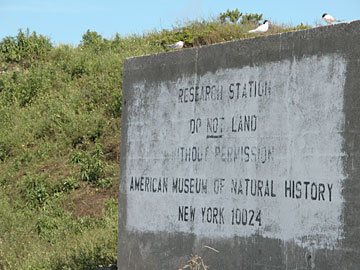 The
largest Common and Roseate Tern nesting site in the Northeast, Great Gull Island
research station was established by the
American
Museum
of Natural History in 1966. Helen Hays, head researcher, has spent 35
consecutive summers here, banding and studying the nesting terns. From May to
September, 10,000 pairs of Common Terns and 1,500 pairs of Roseate Terns keep
her and her staff busy. Originally built as a fort to protect Long Island Sound
and New York City during the Spanish-American War, it was in service until 1949
when it was then turned over to the AMNH. Most of the original buildings on this
17-acre island are overrun by bittersweet. A concrete 3-story
observation tower, 3-room research building, and the “dorm” still remain.
Approximately 40 elevated bird blinds also periscope from the green mat of
vines. The
largest Common and Roseate Tern nesting site in the Northeast, Great Gull Island
research station was established by the
American
Museum
of Natural History in 1966. Helen Hays, head researcher, has spent 35
consecutive summers here, banding and studying the nesting terns. From May to
September, 10,000 pairs of Common Terns and 1,500 pairs of Roseate Terns keep
her and her staff busy. Originally built as a fort to protect Long Island Sound
and New York City during the Spanish-American War, it was in service until 1949
when it was then turned over to the AMNH. Most of the original buildings on this
17-acre island are overrun by bittersweet. A concrete 3-story
observation tower, 3-room research building, and the “dorm” still remain.
Approximately 40 elevated bird blinds also periscope from the green mat of
vines. |
|
The noise and commotion were most obvious (and present our entire visit), but as we took the footpath to the research shed, we had to watch where we walked to avoid stepping on immature terns as they scattered and stumbled to get out of our way. The staff nick-named these immature stages “fat elephants” (the fat, downy chicks), “Orvilles” (the Commons ready to fledge), and “Wilburs” (the fledgling Roseates.) The researchers’ work starts when egg-laying begins in mid May. Hatching can linger late into the season (brooding terns were present even during our visit). Each nest is numbered with a wooden tongue depressor and plotted in areas with creative names like “Middle Earth” and “The Sahara.” At times, over a thousand nests are cataloged in a single day. Because 85% or so of the nesting terns have already been banded, wire cages with trap doors are placed only over nests to capture unbanded adults which are then brought into the lab for weighing, measuring, and banding. The young also are banded within the first days of hatching. This becomes the routine for 10-12 hours a day, every day. Helen is so dedicated that this summer she was only off-island for two days in May. Hatching slows down by mid-summer, as does the length of the workday. |
|
|
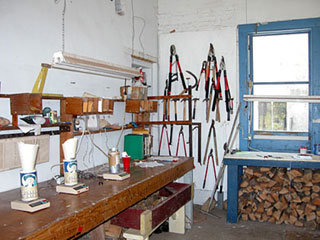 |
The research station was fascinating. Shallow shelves host a large variety of canned goods, sporting hand-written signs in English and Spanish (and German?) to help broaden the language skills of the staff. The walls were decorated with eclectic items found on the island or washed up by the tide. At a window sat a dozen well-used wax candles in a mix of candleholders, evidence of good conversations, held late into soft, summer nights at the casual dining table that occupies most of the room. A primitive office and stock of firewood in the middle room led to the lab at the far end. |
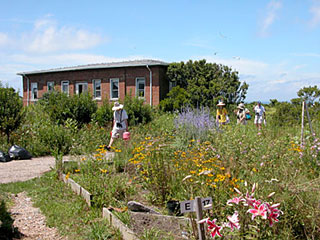 |
Helen first told us not to walk near the vegetation—I thought she said because of the “ticks” (sounded good—and oh, so very familiar.) On the foot path to the tower we brushed against thigh-high vegetation and I thought “so much for the ticks.” |
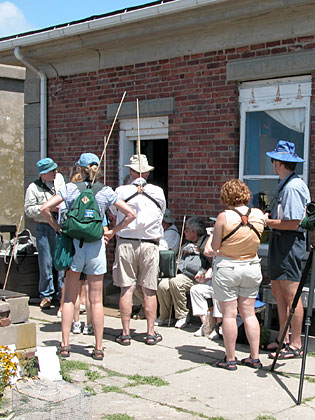
Go to the SongStar home page
Drop us a note
Copyright © 2004 by Joan and Richard L. Becker